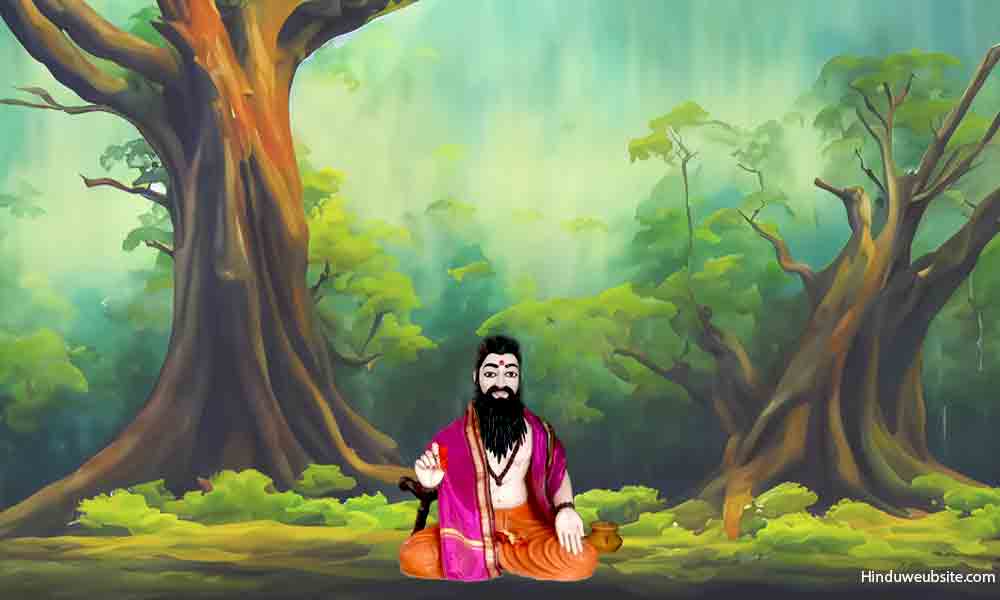
A Brief Biography of Sage Atri, the Vedic Seer

An imaginary painting of Sage Atri. Background AI generated
Summary:
Atri was a Vedic seer who composed several hymns in the Rigveda, the earliest of the Vedas. He is counted among the seven seers (sapta rishis) revered in Hinduism as the direct descendants of Brahma, the creator god. His name was probably derived from the Sanskrit word atra, meaning honorable, respectable. Atra also means free from from the triple (tra) gunas, sattva, rajas and tamas, or in whom the triple gunas are pefectly balanced. Hence, he is qualified for the blessings of the three gods, Brahma, Vishnu and Shiva. He is also mentioned in the Puranas and the epics, the Ramayana and the Mahabharata. The fifth section (mandala) of the Rigveda is named after him since he or his descendants most likely composed most of the hymns in it. Information about his life and work is rather vague.
According to Wikipedia, the hymns of the Rigveda attributed to Atri are known for their melodic structure and spiritual ideas presented as riddles. The hymns include lexical, syntactic, morphological, and verb play, utilizing the flexibility of the Sanskrit language. Scholars like Geldner believe that the hymn 5.44 of the Rigveda in the Atri Mandala is the most difficult riddle in all of the Rigveda. The hymns are also known for their poetic elegance and symbolic description of the Dawn (Usha) as a cheerful woman. Some hymns from other Mandalas of the Vedas are also attributed to the sage or his descendants and disciples.
According to some accounts, he married Anasuya Devi and had three sons through her, Dattatreya, Durvasa, and Chandra. They were said to be partial manifestations or incarnations of Vishnu, Shiva, and Brahma, respectively. Anasuya Devi is known for her exemplary conduct and is counted among the chastest women (pativratas) in the ancient Hindu lore. The epic Ramayana states that during his wanderings in the forests of central and southern India, Lord Rama visited the hermitage (ashrama) of Atri by the side of a lake near Chitrakuta and paid respects to him and his wife. According to the Shiva Purana, Atri did a great penance (tapas) in a forest named Kāmada near Chitrakut accompanied by his wife at a time when a hundred-year drought was ravaging the forest and causing great distress to the trees and other living beings. Unable to bear their suffering, Sati Anasuya requested her husband to do penance and find a solution. Atri agreed and did a great penance while Anasuya served him with humility and devotion. Impressed by their actions, Lord Shiva and Ganga appeared to them and created a perennial water source for the forest bringing the River Ganga to the earth. According to other accounts, impressed by the penances of Atri and the chastity of Anasuya, Brahma, Vishnu, and Shiva granted them three sons. They are considered their partial incarnations or manifestations (amsavataras).
Atri probably lived in southern India or was born there. Atri Samhita, a principal text of the Vaikhasana tradition of Vaishnavism, which flourished in the south, is attributed to him. However, whether it is composed by the ancient seer or another with the same name is still being determined. The text contains instructions regarding morality and righteous conduct. It serves as an instruction manual for the followers of the Vaikhasana tradition, which is still followed by many in the south.
Suggestions for Further Reading
- Maharishi Atri, A Great Sage of Hinduism
- Symbolism of Agni as Brahman, The Supreme Self
- Agasthya the Hindu Sage who drank the oceans
- The Epic Story of Ahalya and Its Hidden Symbolism
- Abhinavagupta, Life and Works
- Anjaneya,or Hanuman of the Ramayana
- An Account of Angirasa, A Hindu Sage
- Bhrigu, the Sage Who Cursed Brahma and Shiva
- Daksha, Daksha's Sacrifice and the Slaying of Daksha
- The Meaning and Significance of Guru in Hinduism
- Jayadeva, A Biography
- Pushtimarg or the Path of Pushti Bhakti
- Sadhus Meaning and Significance
- Siddhas and Siddha Tradition
- Gods of Hinduism - Brahma, the Creator
- Worship of Gods and Goddess inHindusim
- Essays On Dharma
- Esoteric Mystic Hinduism
- Introduction to Hinduism
- Hindu Way of Life
- Essays On Karma
- Hindu Rites and Rituals
- The Origin of The Sanskrit Language
- Symbolism in Hinduism
- Essays on The Upanishads
- Concepts of Hinduism
- Essays on Atman
- Hindu Festivals
- Spiritual Practice
- Right Living
- Yoga of Sorrow
- Happiness
- Mental Health
- Concepts of Buddhism
- General Essays